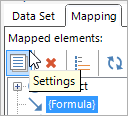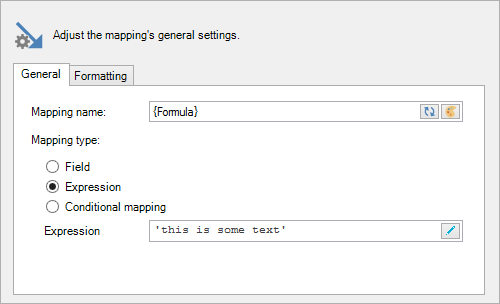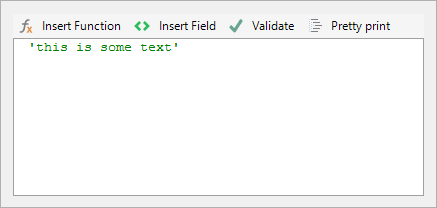Formulas
Formulas are an easy way of quickly inserting an expression in your template. They don't offer the same flexibility as pseudo-fields, but they make up for it in ease-of-use.
Tip Not sure whether you need a formula or a pseudo-field? The difference is explained here.
Concept
Here's how you use formulas in Smart Flows:
- Place the cursor where you want to insert the formula.
- Select the Formula button.
- Define the formula's value.
In step 2, you can use other fields' values so that your formula is actually a modification of other fields' values. For instance, you can use a formula for:
- Calculating totals, subtotals and percentages.
- Editing names in full caps (JOHN) to make them less shouty (John).
- Defining a new constant value for use in your templates.
The possibilities are endless as you can combine all fields and all functions the template builder has to offer.
Creating a formula
To create a formula, follow these steps:
| 1. | Place the cursor where you want the formula to appear in the template. |
| 2. | Select the Formula button in the ribbon. |
| 3. | Define your formula's value by editing the expression. For more information on how to edit expressions, please read this page. |
| 4. | Select OK to confirm the expression. |
| 5. | The XperiDo mapping window for this formula opens, asking you to define the formula's formatting. Change the settings if you want and select OK. |
Your formula is now defined and mapped. By default, it will be named {Formula}.
Editing a formula
After you've created a formula, you can edit its expression or formatting by following these steps:
| 1. | In the data set tab of the pane, select your formula and select Settings: |
| 2. | In the mapping window that opens, go to the General tab. To change the formula's value, select the pencil in the expression box: |
| 3. | This opens a window where you can change the formula's expression. |
Select OK to confirm the expression, and then select OK to close the mapping window.
Understanding the Key Differences Between Formulas and Pseudo-Fields in Template Builder
The Template builder add-in gives you the possibility of using calculations/text editing functions in your templates. There are 2 ways of doing this:
- By using a Formula
- By using a Pseudo-field
Both these features allow the same calculations, but there are a few differences that you should know about.
Properties
Formulas are intended to provide a fast means for calculating something. They offer the same powerful expressions and functions as pseudo-fields, but they are a bit easier to insert. Pseudo-fields, on the other hand, are newly created fields in your data set, which can then be referred to later on. Setting them up takes a bit longer than setting up a formula, but because you define a field, you can use that in other calculations, or use it multiple times in your template.
Advantages
- Formulas are fast to set up.
- You can map pseudo-fields in different places in your document.
- You can sort your loops on pseudo-fields that are defined in that loop.
- You can refer to previously created pseudo-fields in further calculations.
Especially the last bit here is important: being able to refer to previously created pseudo-fields allows chain calculations, such as the following example:
- Use multiple pseudo-fields to calculate multiple subtotals,
- Calculate the sum of all those pseudo-fields in a new pseudo-field,
- Subtract a customer discount from that sum and show it as the grand total by using another pseudo-field.
This is just one example that shows why pseudo-fields are useful, since you can't do this with formulas without defining the same calculations multiple times.
Suggested use
- Use formulas when you only require one calculation that you won't need anywhere else - be it in your template or further calculations.
- Use pseudo-fields when you want to re-use the calculated value in further calculations or when you want to use the calculated value in multiple places in your document.
How to use them
Inserting a formula
- Place your cursor where you want to insert the formula,
- Select the formula button in the ribbon,
- Type in your expression or use the expression wizard,
- Set your formula's formatting,
- Select OK to finalize everything.
Inserting a pseudo-field
- In the pane's data set tab, select the pseudo-field's parent field (the pseudo-field will be created as a child element of this field),
- Select the Add pseudo-field button in the pane's data set tab,
- Set your pseudo-field's settings, such as the name, the type and most importantly: the calculations,
- Select OK. A new field has now been created under the selected parent field,
- Place your cursor where you want to insert the pseudo-field,
- Double-click the field in the pane's data set tab to insert the field in your template.
Editing a formula
- In the pane's mapping tab, double-click the formula you want to edit. A window will pop up,
- In this window, in the Field Selection section, hover over the value and select the pencil that appears,
- This opens the expression editor where you can change your formula.
Editing a pseudo-field
- In the pane's data set tab, select the pseudo-field you want to edit,
- Select the Edit pseudo-field button in the pane's data set tab,
- This opens the pseudo-field window which includes the expression editor where you can change your formula.






